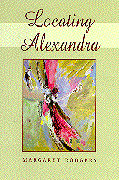

![]()

|
Locating Alexandra.
Margaret Rodgers. Subject Headings:
Grades 10 and up / Ages 15 and up.
***/4
|
excerpt:
Painting is like life itself: you learn as you go along, what to select, what to leave out -- this is very important, what goes with what, how to get interest and excitement with unity and balance, how to take the bad days with the good and last but not least how to enjoy and learn at the same time.-- Alexandra Luke
MARGARET ALEXANDER LUKE MCLAUGHLIN had two completely different names and identities. Artistically she was known as Alexandra Luke. Personally, she was known as Margaret McLaughlin. Many friends in her upper-class social set had no idea she was a hugely successful painter. This book, as its title states, attempts to place the woman within her various milieus.
It spite of being described by colleagues Jack Bush and Harold Town as the most successful female painter in Canada, Luke faced many obstacles. Locating Alexandra traces the complexities of her life: her struggle to establish a place in the art world; her unhappy marriage to wealthy, un-supportive man; the demands placed on her as a mother and society matron; her involvement with the spiritualism of Gurdjieff; and the artistic discrimination she suffered because of her gender. Her story is an archetypal example of the tensions and trials of a woman striving for success in a traditionally male domain.
Unfortunately, the writing in Locating Alexandra is not as fascinating as its subject. Author Margaret Rodgers originally wrote it as a thesis, and she has not successfully transformed it into a monograph for the lay reader; the result is confusing in both style and approach.
Rodgers handles each aspect of Luke's life separately, and though each section is well written (and intrinsically interesting), the sections do not fuse into a whole. The reader does not get a coherent sense of the artist's life.
Some of the parts, however, are worth the price of the book. The feminist analysis of marriage and motherhood in the chapter "Personal Life" is especially strong. And the discussion of the philosophical thought of Luke and her colleagues, and their involvement with mysticism, gives the reader a sense of the intellectual ferment that surrounded them.
Rodgers is the director of the Visual Arts Centre of Clarington, Ontario. Non artists will appreciate her straight-forward language and lack of "art-speak." Her slim monograph has no index, but includes a comprehensive bibliography of "works consulted."
Unfortunately, this book about a visual artist does not have colour illustrations of her work. Black-and-white reproductions cannot provide an understanding of the importance of colour in Luke's definition of space and depth. I was fortunate to have access to the 1987 catalogue Alexandra Luke: Continued Searching (Robert McLaughlin Gallery, Oshawa, Ontario) to see some examples of Luke's use of colour.
In spite of its shortcomings, I recommend this work. It's a welcome addition to the abysmally small number of studies of Canadian Women Artists. Gender Studies and Art programs will be enriched by it.
Recommended.
Frances Daw Bergles is librarian at the Mendel Art Gallery in Saskatoon.
To comment on this title or this review, send mail to cmeditor@mts.net.
![]()
Copyright © 1996 the Manitoba Library Association.
Reproduction for personal use is permitted only if this copyright notice
is maintained. Any other reproduction is prohibited without permission.
Published by
The Manitoba Library Association
ISSN 1201-9364
![]()